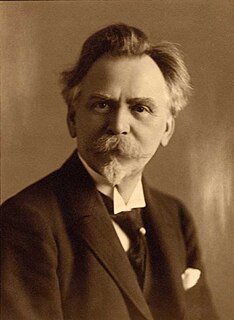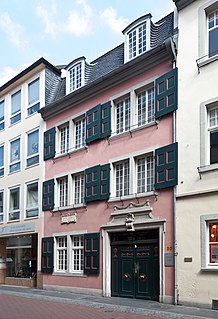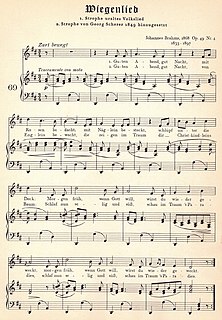
Johannes Brahms was a German composer, pianist, and conductor of the mid-Romantic period. Born in Hamburg into a Lutheran family, he spent much of his professional life in Vienna. He is sometimes grouped with Johann Sebastian Bach and Ludwig van Beethoven as one of the "Three Bs" of music, a comment originally made by the nineteenth-century conductor Hans von Bülow.

Robert Schumann was a German composer, pianist, and influential music critic. He is widely regarded as one of the greatest composers of the Romantic era. Schumann left the study of law, intending to pursue a career as a virtuoso pianist. His teacher, Friedrich Wieck, a German pianist, had assured him that he could become the finest pianist in Europe, but a hand injury ended this dream. Schumann then focused his musical energies on composing.

Clara Josephine Schumann was a German pianist, composer, and piano teacher. Regarded as one of the most distinguished pianists of the Romantic era, she exerted her influence over a 61-year concert career, changing the format and repertoire of the piano recital from displays of virtuosity to programs of serious works. She also composed solo piano pieces, a piano concerto, chamber music, choral pieces, and songs.

Claudio Arrau León was a Chilean pianist known for his interpretations of a vast repertoire spanning the baroque to 20th-century composers, especially Bach, Beethoven, Schubert, Chopin, Schumann, Liszt and Brahms. He is widely considered one of the greatest pianists of the twentieth century.

Joseph Joachim was a Hungarian violinist, conductor, composer and teacher who made an international career, based in Hanover and Berlin. A close collaborator of Johannes Brahms, he is widely regarded as one of the most significant violinists of the 19th century.

A German Requiem, to Words of the Holy Scriptures, Op. 45 by Johannes Brahms, is a large-scale work for chorus, orchestra, a soprano and a baritone soloist, composed between 1865 and 1868. It comprises seven movements, which together last 65 to 80 minutes, making this work Brahms's longest composition. A German Requiem is sacred but non-liturgical, and unlike a long tradition of the Latin Requiem, A German Requiem, as its title states, is a Requiem in the German language.

Marlos Nobre is a Brazilian composer. He has received commissions from numerous institutions, including the Ministry of Culture in Spain, the Free University of Music of São Paulo, the Neuchâtel Chamber Orchestra in Switzerland, The Apollon Foundation in Bremen, Germany and the Maracaibo Music Festival in Venezuela. He has also sat on the juries of numerous international music competitions, including the Cità di Alessandria Prize, the Arthur Rubinstein Piano Master Competition and the Paloma O'Shea Santander International Piano Competition.
Albert Hermann Dietrich, was a German composer and conductor. In addition to his work, he is remembered for his friendship with Johannes Brahms.

Jenő Hubay, Jenő Hubay von Szalatna, Hungarian: szalatnai Hubay Jenő, also known by his German name Eugen Huber, was a Hungarian violinist, composer and music teacher.

G. Henle Verlag is a German music publishing house specialising in Urtext editions of classical music. The catalogue includes works by composers from different epochs periods, in particular composers from the Baroque to the early twentieth century whose works are no longer subject to copyright. In addition to sheet music, G. Henle Publishers also produces scholarly complete editions, books, reference works, and journals. Since 1995, Henle the range also includes pocket scores. In 2016 Henle began offering the Urtext editions in digital format in an app for iOS and Android tablets.

Andreas Boyde is a German pianist.
Johannes Brahms' String Sextet No. 2 in G major, Opus 36 was composed during the years of 1864–1865 and published by the firm of Fritz Simrock. It was first performed in Boston, Massachusetts on October 11, 1866, with the European premiere following the next month in Zurich. The work is scored for two violins, two violas, and two celli, and has four movements:
- Allegro non troppo
- Scherzo – Allegro non troppo – Presto giocoso
- Adagio
- Poco allegro

The Beethoven House in Bonn, Germany, is a memorial site, museum and cultural institution serving various purposes. Founded in 1889 by the Beethoven-Haus association, it studies the life and work of composer Ludwig van Beethoven.

N. Simrock was a German music publisher founded by Nikolaus Simrock which published many 19th-century German classical music composers. It was acquired in 1929 by Anton Benjamin.

Carl Ernst Naumann was a German organist, composer, conductor, editor, arranger and musicologist. He is best known now as an arranger and editor of the music of J.S. Bach, Mozart and Mendelssohn. He was a friend of Schumann and Brahms, and conducted the first performance of the latter's Alto Rhapsody in 1870.
Margit L. McCorkle is a musicologist, music bibliographer, editor, translator, pianist, and harpsichordist.

Johannes Brahms's "Wiegenlied", Op. 49, No. 4, is a lied for voice and piano which was first published in 1868. It is one of the composer's most popular pieces.
Joachim Draheim is a German musicologist, music teacher and classical pianist.
Günter Ludwig is a German pianist.





















